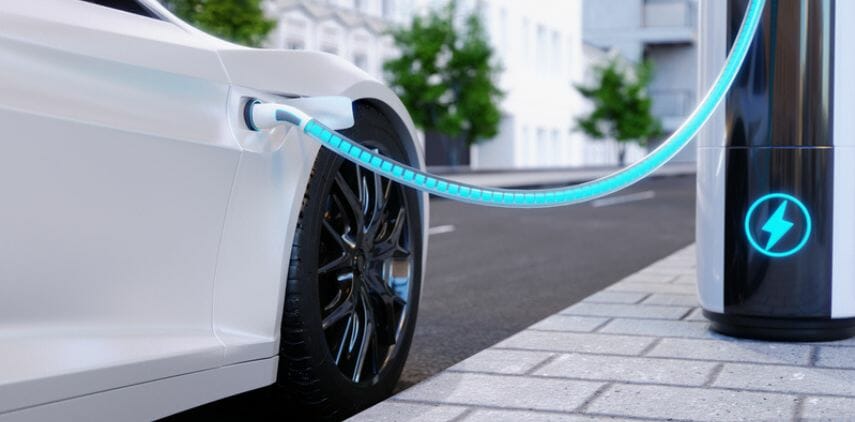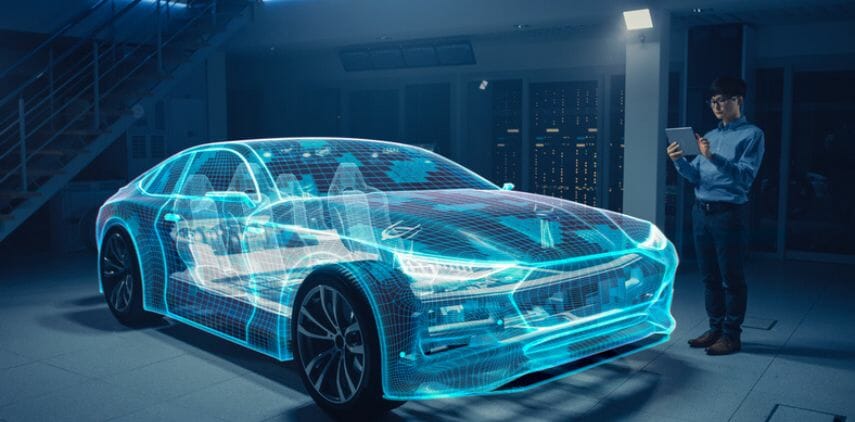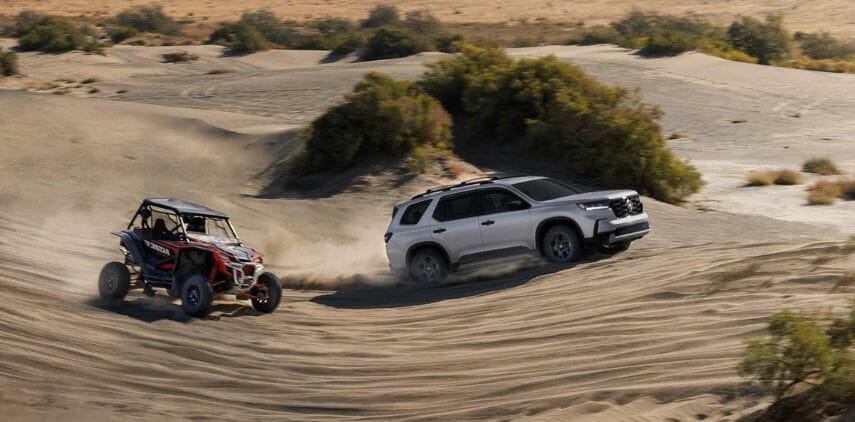Overview
SUVs have been a hot favorite among car enthusiasts for decades now, and for all the right reasons. Oozing luxury and class, these spacious vehicles are best-suited for driving in diverse terrains. With high cargo capacity, excellent standard safety features, and powerful engines, SUVs are fun to drive.
Table of Contents
What Does an SUV Stand for?
The acronym “SUV” stands for a sport utility vehicle. SUVs entered the American lexicon in the 1970s as a term for high-riding, four-wheel-drive vehicles with off-road capabilities. The term was first used when the Jeep Cherokee (SJ) came into the market in 1974. The 1984 Jeep Cherokee (XJ) is often considered to be the first SUV, in the modern sense of the term.
Along with the other cars on the market, SUVs were designed to offer consumers more utility than mainstream sedans. The SUV saw a swift rise in popularity as soon as it was introduced, and by 1990 sales of large passenger vehicles had surpassed traditional car sales.
SUV Meaning: What is an SUV?
SUV is an umbrella term for a family of vehicles with a high seating capacity that is typically offered with four-wheel drive. They usually come equipped with increased cargo storage, improved towing capacity, and off-road capabilities such as low-range gearing. These cars are not only used by families looking for more room than the average sedan but also by people who enjoy the freedom of driving off-road occasionally.
An SUV, or sport utility vehicle, comes with rugged features to make it more suitable for driving on rough terrains. The four-wheel drive system offers better traction in adverse conditions like snow and sand. During the 1970s and ’80s, when SUVs first hit the market, they were referred to as open-air four-wheel-drive vehicles used for leisure purposes. The vehicle has undergone an impressive evolution over the years, making it one of the most popular purchases in the automotive industry in recent times.
There is no designated standard of what constitutes an SUV so there is no official definition for the term. However, by far the most common usage of the term SUV in practice is to describe a body-on-frame, four-wheel-drive vehicle with raised ground clearance, and which incorporates an independent front and rear suspension.
Do All SUVs Have A 4×4 Driving System?
The answer is, no. Many SUVs these days are equipped with an optional 4X4, but they may not be present in all models.
The 4X4 driving system or the four-wheel drive is a vital part of an SUV. In this system of transmission, the drivetrain provides torque to all the four wheels of the vehicle, simultaneously. While the all-wheel drive is an automatic system, 4X4 has to be turned on manually. It provides the vehicle with traction while driving on snow, ice, or rocky roads. The two pairs of wheels are deeply engaged in the driving process, and they offer greater control while driving.
If you’re an off-roader, 4X4 would be a great way to enhance your driving experience, and at the same time, it’ll ensure better grip and more safety.
Are SUV and Crossover the Same?
If you are searching for an SUV, the terms you’ll most likely come across are SUVs and crossovers. They look similar, but the terms actually refer to two completely different vehicles.
A traditional SUV is part of a family of large sport-utility vehicles (SUV) that includes minivans and pickup trucks. These types of vehicles typically sit high off the ground and have a long wheelbase which gives them additional stability during turns. They have high-powered engines, four-wheel drive, a robust body, and a roomy interior.
Crossovers are a new type of vehicle that is part SUV, part car, built with a unibody frame. The two basic parts of a crossover are the car-like body on top and the SUV-like component under the hood. This type of vehicle typically looks like a small SUV with a large windshield and usually has seating for five people or more. The majority of these vehicles have an independent front suspension, so the body and chassis can flex without compromising the vehicle’s handling. Crossovers are also offered with all-wheel drive capability to further enhance their off-road abilities.
Crossover Vs. SUV
SUV is the reigning champion of the off-road world, but crossover offers the best of both worlds. To understand their similarities and differences, let’s take a look at the pros and cons of the two.
SUV
Pros
- Spacious – SUVs come with a large amount of space, that’s why it’s perfect for traveling with a big family or a large group of friends. The roomy interior is more comfortable than a sedan and offers more storage areas for keeping luggage.
- Versatile – SUVs can be used for adventurous off-roading, as well as for everyday usage. While they are designed to run on rough terrains, you’ll have a comfortable riding experience even on regular roads. SUVs generally come with powerful engines, and a superior towing capacity, which is definitely a plus.
- Sturdy – The rugged body of an SUV ensures safety and durability. The sturdy build of this vehicle gives you a new lease of confidence when you’re driving on mountains or any other risky terrains.
- Higher ground clearance – The high ground clearance of an SUV allows you to drive through obstacles with ease, whether you’re driving through snow, trailheads, or water. This makes SUVs more resistant to damage and absorbs road shocks more efficiently.
Cons
- More fuel cost – One of the major disadvantages of an SUV is its fuel cost. It’s a no-brainer that a large vehicle requires more fuel to run than any other small vehicle. SUV manufacturers have been trying to compensate for this drawback, but it’s still a long way to go. The good news is, electric SUVs are already here, and they could be a game changer.
- C02 emission – For a vehicle that consumes a heavy amount of fuel, it’s quite evident that the carbon dioxide emission will be on the higher side.
- Heavy – The spacious vehicle also comes with a heavy weight. While it’s a great choice for off-roading and traveling with more passengers, it can be a bit troublesome to run errands with a huge SUV.
Crossover
Pros
- Smooth ride – As crossovers are less bulkier than SUVs, they offer a smooth and comfortable ride. They are more practical to use on a daily basis and are a treat to drive.
- Low fuel consumption – If you compare with SUVs, crossovers consume less fuel, and as a result, the overall cost of owning the vehicle goes down significantly.
- Large seating capacity – Crossovers are generally equipped with two-row seating, and even three, in some cases. They are spacious, and also have a convenient storage area.
- More affordable than SUVs – If you’re willing to experience the ruggedness of an SUV without making a huge splurge, a crossover can be a good option. It costs less than an SUV and offers almost the same amount of sturdiness, luxury and comfort.
Cons
- Limited off-road capability – When it comes to off-roading, the performance of a crossback is not at par with a full-size SUV.
- More fuel cost than regular cars – It may not be as fuel-hungry as a traditional SUV, but the fuel consumption is still high when compared to a regular sedan or any other car.
SUV Types: What Are the Different Categories of SUV?
With the rising popularity, sports utility vehicles have not only evolved to a great extent, but manufacturers have also focused on diversifying the sizes of the vehicles. Now there is a whole range of options available for SUVs, including small, mid-size, sub-compact, compact, standard, and full-size SUVs. However, you must keep in mind that the size variations are not entirely rigid, and there is a grey area between the different categories.
Small SUVs
A small SUV can seat as few as four passengers. These compact cars are more nimble than bigger SUVs but not quite as big, making them the perfect car for maneuvering through small cities and parking lots. These cars are also extremely fuel-efficient. Volvo XC40, Hyundai Tucson, Range Rover Evoque are some of the notable small SUVs you can find in the market today.
Mid-size SUV
Mid-size SUVs are valued for their blend of size, power, and fuel efficiency. They are the ideal family car if you’re looking for a vehicle that can handle everyday tasks but still provide good mileage. They offer a smooth ride, a spacious cargo area, and often come with an optional third-row seat, but are much smaller than the full-size SUVs. Some of the popular mid-size SUVs are Kia Telluride, Dodge Durango, Hyundai Santa Fe, to name a few.
Sub-compact SUVs
Sub-compact SUVs offer impressive mileage due to their small size and cost less than their bigger counterparts. However, the seating capacity and the cargo space are less than what we find in a typical compact SUV. If you’re looking for a vehicle that is nimble and offers better fuel economy, then you may consider a sub-compact such as Mazda CX-30, Hyundai Kona, Honda HR-V.
Compact SUVs
Compact SUVs are a little bigger than mini SUVs, but they have better performance. They are not as small as sedans or hatchbacks. Compact SUVs are a good choice for car connoisseurs as they are stylish, comfortable, economical, and come with luxurious interiors like a usual SUV. Mazda CX-5, Subaru Forester, Volkswagen Tiguan are some of the popular compact SUVs you can find out there.
Standard SUVs
Standard SUVs are great for traveling with a big family, or for off-roading. They have a high towing capacity, better shock absorption, and more interior space. However, the fuel economy is much less than small SUVs, and emission is extremely high. But in terms of comfort, storage space, and crash safety, a standard SUV has an upper hand. Ford Edge, Jeep Grand Cherokee, Mitsubishi Outlander are some of the leading standard SUVs.
Large/ Full-Size SUVs
As the name suggests, full-size SUVs are the biggest of the lot. In terms of power, maneuvering, and off-roading, a large SUV is unmatchable by all standards. It offers more seating capacity, spacious cargo area, efficient shock absorption, and a luxurious driving experience, even on the roughest of roads. But as you can guess, the fuel consumption, emission, and price are on the higher side. Chevrolet Tahoe, Ford Expedition, GMC Yukon are a few latest large SUVs dominating the roads today.
Some Famous Brands & Models of SUVs
Some of the biggest and globally acknowledged SUV brands are:
- BMW (X1, X2, X3, X4, iX3)
- Jeep (Cherokee, Compass)
- Chevrolet (Blazer, Equinox, Tahoe, Traverse)
- Nissan (Magnite, KICKS)
- Ford (EcoSport, Endeavour, Edge)
The Future of SUVs: It’s All Electric
Electric vehicles or EVs are the latest buzz in the world, and SUVs have been quick enough to adapt to the new technologies. Electric SUVs are eco-friendly, suitable for long rides, and provide the safety and comfort of a classic SUV. Models like Mercedes Benz EQC, Audi e-Tron, Kia e-Niro, MG ZS EV are some of the best EVs you can buy in 2021.
Final Thoughts
Ever since the first SUV hit the road, manufacturers never had to look back. Even in 2021, SUVs enjoy the same popularity as they did back in the ’80s, and it’s only going to soar higher. Despite the hefty price tags, the luxury, comfort, and style of an SUV remain unparalleled by all standards. If you’re planning to buy a sports car in 2021, SUVs can be a good choice. With a lot of recent developments going on, the future looks bright. Before making a final decision, don’t forget to conduct thorough research to make sure you’re buying a vehicle that caters to your needs and fits the purpose.






